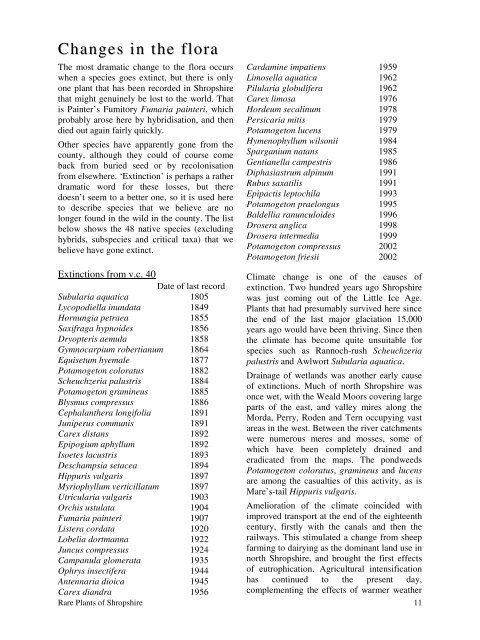Shropshire - Botanical Society of the British Isles
Shropshire - Botanical Society of the British Isles
Shropshire - Botanical Society of the British Isles
- No tags were found...
You also want an ePaper? Increase the reach of your titles
YUMPU automatically turns print PDFs into web optimized ePapers that Google loves.
Changes in <strong>the</strong> floraThe most dramatic change to <strong>the</strong> flora occurswhen a species goes extinct, but <strong>the</strong>re is onlyone plant that has been recorded in <strong>Shropshire</strong>that might genuinely be lost to <strong>the</strong> world. Thatis Painter’s Fumitory Fumaria painteri, whichprobably arose here by hybridisation, and <strong>the</strong>ndied out again fairly quickly.O<strong>the</strong>r species have apparently gone from <strong>the</strong>county, although <strong>the</strong>y could <strong>of</strong> course comeback from buried seed or by recolonisationfrom elsewhere. ‘Extinction’ is perhaps a ra<strong>the</strong>rdramatic word for <strong>the</strong>se losses, but <strong>the</strong>redoesn’t seem to a better one, so it is used hereto describe species that we believe are nolonger found in <strong>the</strong> wild in <strong>the</strong> county. The listbelow shows <strong>the</strong> 48 native species (excludinghybrids, subspecies and critical taxa) that webelieve have gone extinct.Extinctions from v.c. 40Date <strong>of</strong> last recordSubularia aquatica 1805Lycopodiella inundata 1849Hornungia petraea 1855Saxifraga hypnoides 1856Dryopteris aemula 1858Gymnocarpium robertianum 1864Equisetum hyemale 1877Potamogeton coloratus 1882Scheuchzeria palustris 1884Potamogeton gramineus 1885Blysmus compressus 1886Cephalan<strong>the</strong>ra longifolia 1891Juniperus communis 1891Carex distans 1892Epipogium aphyllum 1892Isoetes lacustris 1893Deschampsia setacea 1894Hippuris vulgaris 1897Myriophyllum verticillatum 1897Utricularia vulgaris 1903Orchis ustulata 1904Fumaria painteri 1907Listera cordata 1920Lobelia dortmanna 1922Juncus compressus 1924Campanula glomerata 1935Ophrys insectifera 1944Antennaria dioica 1945Cardamine impatiens 1959Limosella aquatica 1962Pilularia globulifera 1962Carex limosa 1976Hordeum secalinum 1978Persicaria mitis 1979Potamogeton lucens 1979Hymenophyllum wilsonii 1984Sparganium natans 1985Gentianella campestris 1986Diphasiastrum alpinum 1991Rubus saxatilis 1991Epipactis leptochila 1993Potamogeton praelongus 1995Baldellia ranunculoides 1996Drosera anglica 1998Drosera intermedia 1999Potamogeton compressus 2002Potamogeton friesii 2002Climate change is one <strong>of</strong> <strong>the</strong> causes <strong>of</strong>extinction. Two hundred years ago <strong>Shropshire</strong>was just coming out <strong>of</strong> <strong>the</strong> Little Ice Age.Plants that had presumably survived here since<strong>the</strong> end <strong>of</strong> <strong>the</strong> last major glaciation 15,000years ago would have been thriving. Since <strong>the</strong>n<strong>the</strong> climate has become quite unsuitable forspecies such as Rannoch-rush Scheuchzeriapalustris and Awlwort Subularia aquatica.Drainage <strong>of</strong> wetlands was ano<strong>the</strong>r early cause<strong>of</strong> extinctions. Much <strong>of</strong> north <strong>Shropshire</strong> wasonce wet, with <strong>the</strong> Weald Moors covering largeparts <strong>of</strong> <strong>the</strong> east, and valley mires along <strong>the</strong>Morda, Perry, Roden and Tern occupying vastareas in <strong>the</strong> west. Between <strong>the</strong> river catchmentswere numerous meres and mosses, some <strong>of</strong>which have been completely drained anderadicated from <strong>the</strong> maps. The pondweedsPotamogeton coloratus, gramineus and lucensare among <strong>the</strong> casualties <strong>of</strong> this activity, as isMare’s-tail Hippuris vulgaris.Amelioration <strong>of</strong> <strong>the</strong> climate coincided withimproved transport at <strong>the</strong> end <strong>of</strong> <strong>the</strong> eighteenthcentury, firstly with <strong>the</strong> canals and <strong>the</strong>n <strong>the</strong>railways. This stimulated a change from sheepfarming to dairying as <strong>the</strong> dominant land use innorth <strong>Shropshire</strong>, and brought <strong>the</strong> first effects<strong>of</strong> eutrophication. Agricultural intensificationhas continued to <strong>the</strong> present day,Carex diandra 1956 complementing <strong>the</strong> effects <strong>of</strong> warmer wea<strong>the</strong>rRare Plants <strong>of</strong> <strong>Shropshire</strong> 11
















